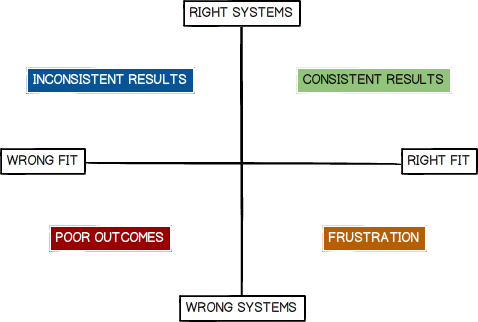There are many systems in place at churches of every size, location & style; most are borne out of necessity, but some are adopted because they’ve been seen at work in other churches. While the list of church systems could be exhaustive, I’ve come to define them into three distinct but important categories. There are, of course, many, many sub-systems within these broad categories, but I believe each of the three to be vitally important to creating, maintaining and exporting a healthy culture.
The diagram below illustrates the following:
Right Fit + Right Systems = Consistent Results
Right Fit + Wrong Systems = Frustration
Wrong Fit + Right Systems = Inconsistent Results
Wrong Fit + Wrong Systems = Poor Outcomes

I believe that it’s possible to “right fit” every person. As my good friend pastor Brad Stahl (Volunteer pastor at Gateway Church) says, “Everybody’s a ’10′ somewhere!”. The right fit with the right systems is always the goal.
Relational Responsibility System
Once you get past about 50 people that you can know well, it’s hard to keep up with the rest of the people in your sphere of influence. So, in essence, any local church with more than 50 people is, for all intents and purposes, a mega church (which is commonly associated with being “too big” for many). Today, many churches have adopted some form of an electronic database for keeping track of attendees (some still track membership – but if they’re a member, aren’t they attending & serving? Why count membership?). The practicality of an electronic ‘Rolodex’ is helpful, but ultimately insufficient.
The point of keeping up with ‘people information’ is to help facilitate relationships, so any tool that merely acts as a glorified Rolodex is only marginally useful.
Of course many companies have realized this, thus the plethora of church management software offerings for churches of every size. Every one of these software solutions has built their tool from their own bias and understanding of how they would ‘do ministry’. As a result, while many offer similar features, the reality is that the way the software works is ultimately geared towards a way of doing ministry. If you go this route (and I recommend that you do), make sure the software you choose values what you value and functions along how your church does day-to-day ministry. A quick note: there’s not a single platform that’s doing everything really well, so you’re simply choosing the one that fits >80% of your relational responsibility needs.
Stewardship System
Church finances are obviously important, but I’ve come to understand that finances are only one part of being a good steward. As such, I believe that stewardship encompasses a different mindset than is typically found in the conventional church financial office.
Being a steward is defined as a responsibility to take care of something belonging to someone else.
From shepherding people well to wisely managing finances to designating resources effectively, a stewardship system involves a holistic approach. The leader overseeing this system is both generous and wise and manages this system (and sub-systems) through the filter of being a good steward more than ensuring Account Receivable and Accounts Payable are up-to-date. Church leaders are entrusted with much, so much is required. Luke 12:48 says: “From everyone who has been given much, much will be demanded; and from the one who has been entrusted with much, much more will be asked.” The fundamental shift of leading from this paradigm changes things up.
Communications System
It’s interesting to me how much emphasis the vast majority of churches place on having an event, promotion or need shared from the platform on weekends. Announcements have their place, but the truth is that by the time something makes it to the announcements from the senior pastor (which should be very few things indeed), the audience should have had the opportunity to hear about it from at least five other methods. I don’t think enough churches are thinking about their external communications nearly enough. Email (mass group emails as well as demographic-specific campaigns), print, website, social media, word-of-mouth, advertising, groups promotion and the like are all avenues that should be strategically coordinated (editorial calendars, anyone?).
Great communication ensures the right message is getting to the right people in the right way at the right time.
In addition to external communications, churches need to also put the same effort into internal communications. Frankly, in even smaller churches, the proverbial left hand doesn’t often know what the right hand is doing. As a result, people and project details often fall through the cracks.
In both cases, a unified communications system is less about a specific tool(s) and more about defining a healthy way of communicating effectively.
Owning these three systems is critical to churches. Is your church leveraging these three important systems? Share your thoughts in the comments below or reach out to me on Twitter: @anthonycoppedge
Read more from Anthony here.

Tags: Anthony Coppedge, Leadership Engine, Structure, Systems
|
What is MyVisionRoom? > | Back to Leadership >























